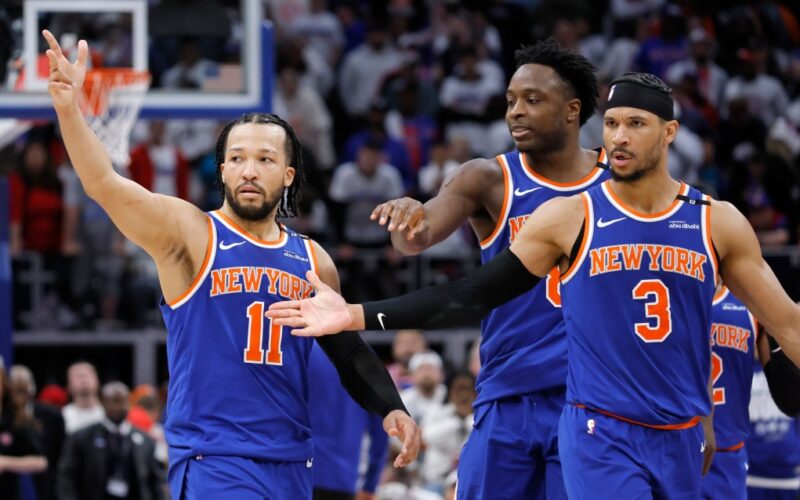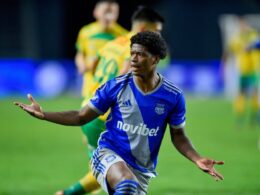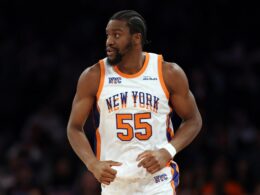Eight hundred and twenty dollars.
That’s how much you’d have to bet on the Boston Celtics to win their second-round playoff series against the Knicks just to make a hundred bucks back. Las Vegas isn’t subtle. Neither are the numbers. The Knicks aren’t just underdogs in the Eastern Conference Semifinals — they’re the longest shot left on the board.
And by every measure, they should be. The Celtics swept the regular-season series, 4-0. Three of those wins were by double digits. Two were by 20 or more. In Boston’s most dominant moments, it looked like the Knicks were playing uphill on ice.
But not all blowouts are built the same — and not every loss tells the full story.
The final meeting between these teams was different. An April 8 game at Madison Square Garden that needed five extra minutes to settle. An overtime loss, yes — but one that saw the Knicks punch back, keep pace, and nearly steal it. That game, they believe, revealed something: not a victory, but a blueprint.
“I feel like we played better in that game,” said Jalen Brunson. “We adjusted from the first three times we played them — obviously still not getting it done, but definitely played better and competed better than the first three games. So that’s something we can look at and build off of.”
The odds are long, but they’re not zero. This Knicks team was built for a series like this.
OG Anunoby re-signed for $212 million to guard stars like Jayson Tatum. The Knicks paid the steep cost of five first-round draft picks for Mikal Bridges to matchup against the likes of a Jaylen Brown. Karl-Anthony Towns adds the kind of five-out offensive pop that makes the reigning champs special. And the captain just earned Clutch Player of the Year. Brunson is ready for whatever the Celtics defense will throw at him.
If the Knicks are going to shock the basketball world, it starts with Brunson — the head of a New York snake determined to strike when the moment matters most. The Celtics won every meeting in the regular season, but come Monday, the record resets. The scoreboard goes back to zero. And for all the lopsided outcomes earlier this year, the Knicks believe there’s a clearer path now — one rooted in adjustments, rhythm, and the defensive edge that defined their first-round grit.
And if the game is close late? The Knicks have the one thing you can’t teach: a closer. Brunson doesn’t need much — just a sliver of space and a few ticks on the clock to do what he does best. One move. One bucket. One shot that could flip a game — maybe even the series.
**
There’s a reason the fourth meeting between the Knicks and Celtics means more than the three that came before it: Mitchell Robinson didn’t make his long-awaited return until Feb. 28 in Memphis.
When the Knicks traded for All-Star big man Karl-Anthony Towns, the blueprint was clear: Towns at the four, Robinson anchoring the five — mirroring the frontcourt formula Minnesota used alongside four-time Defensive Player of the Year Rudy Gobert. But Robinson’s extended recovery from offseason ankle surgery delayed that vision. It wasn’t until the season’s final stretch that the Knicks finally saw their twin towers in action.
The defensive impact was immediate. Before Robinson returned, the Knicks ranked 21st in defensive efficiency. From his return through the regular-season finale, they surged to eighth.
It wasn’t just a boost in metrics — it was identity. The Knicks, often out-sized throughout the year, suddenly had length, rim protection and rebounding in one of the most physical frontcourts in the league.
Towns and Robinson only logged 47 minutes together across 10 regular-season games, yet in that limited sample, New York outscored opponents by 9.2 points per 100 possessions. Their pairing didn’t profile as dominant against the Pistons — a minus-4.9 net rating in 40 minutes across six games — but Robinson’s presence alone gives New York critical lineup flexibility heading into a second-round series defined by size, shooting, and second-chance points.
If the Celtics go big with any two of Kristaps Porzingis, Al Horford, or Luke Kornet, the Knicks can answer with seven-footers of their own. The two-big look gives New York a shot at controlling the paint while better contesting Boston’s five-out spacing.
“When he’s on the floor, he’s a positive for our team with his natural, God-given intangibles and obviously his ability to defend at a high level,” Towns said of Robinson. “It gives us a different offensive attack scheme and it gives us more different opportunities that we have in our lineups to do.”
The impact will be felt most on the glass. The Celtics don’t just shoot threes — they chase down misses and create second-chance threes that demoralize defenses. Robinson is the Knicks’ best shot at neutralizing that.
“If you run in, [the rebounds will] probably go over your head,” Thibodeau said. “So our guards have to do a great job covering the long ones. Their bigs are real active, and then they come from behind, so we have to have an awareness with that as well. They’re defending champions for a reason.”
Boston punishes breakdowns. But with Robinson back, the Knicks finally have the interior presence to disrupt second efforts, control the boards — and maybe even reshape the matchup. It also gives Towns a chance to lean further into his defensive potential away from the paint.
“Just gotta be more a perimeter defender and also tap into that Minnesota experience I had with Rudy Gobert,” he said. “Especially in the playoffs, I feel like I’ve shown the world I can do it at a high level, especially in last year’s playoffs. So I just want to carry that experience, grow on that, and get even better.”
**
Context matters. The Celtics tied an NBA record with 29 made threes against the Knicks in their season opener — but that was on ring night, against a Knicks team still stitching together its identity midway through training camp. Boston blitzed them in a moment they were never built to withstand.
Game 2 wasn’t much better: a 27-point blowout with Anunoby sidelined. Tatum poured in 40 points on 50 percent shooting from both the field and beyond the arc. Without their defensive stopper, the Knicks never stood a chance. If they have any hope in Round 2, they’ll need him healthy and engaged — matching Tatum’s minutes every possession, every quarter.
The third meeting followed a familiar script: Boston built a lead, the Knicks rallied late, and the Celtics answered with a backbreaking run to win by 13. Robinson’s return came just days after. And the fourth matchup? It came on the business end of a brutal five-games-in-seven-nights stretch — and yet, the Knicks still pushed Boston to overtime.
They got better. Each game, a little more competitive. A little more connected.
“The third game was a four-point game in the fourth quarter, too, but you have to play,” Thibodeau said. “They can go on runs the way that they shoot threes. A bad minute or two — that could be the difference in a 10-point swing.”
Those moments — the lapses — have cost the Knicks all season. It’s why they were 0-10 against title contenders in the regular season. And it’s why Thibodeau’s most consistent challenge to his group has been the simplest, yet most elusive: play 48 complete minutes.
“[We need to] play better than we did throughout the regular season,” said Brunson. “Be better, ready to do it from the jump, knowing it’s going to be a game of runs, knowing that they’re capable of doing a lot of great things. We’ve gotta keep our composure, stick together and just make sure that we continue to play throughout the entire game.”
That’s what the Celtics demand: composure, unity, precision — for four full quarters. Anything less, and Boston will make you pay.
“They’re a terrific team, defending champions,” Thibodeau said. “Each game you learn something. You’ve got to play for 48 minutes. We thought the last game there were some things that we could have done better, but it was an overtime game — so you just find a way to win.”
And now? That 0-4 regular-season record? It’s irrelevant. Game 1 starts fresh. The score is 0-0. The series is zip-zip. With a trip to the Eastern Conference Finals on the line.
How do the Knicks change the narrative? How do they play a full 48-minute game?
“It’s maximum concentration, maximum effort,” Thibodeau said.
That’s the only path. Because anything less — a breakdown, a missed rotation there, a loose ball not secured one too many times — and the Celtics will do what they’ve done all season.
But if the Knicks stay locked in? If they bring the fight they showed in their most competitive moments?
Well, it’s the NBA. It’s the playoffs. And the record says 0-0 for a reason.








